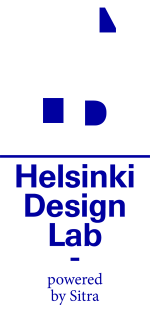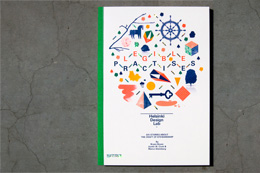Another Saturday morning, another Weeknote. This week was not atypically busy, but it sure felt like it – in a good way. Progress was made.
An important theme this month (bye, January) has been reminding everyone around us that Helsinki Design Lab is a mission-driven initiative, rather than just an event. Marco spent a lot of time re-presenting the full scope of the project both in and out of house and it's something that we need to continually push back on since this is a new development.
Helsinki Design Lab 1968 and 2008 were singular events. Like any gathering of great minds, the electricity in the air set other things in motion but those were ancillary benefits and not the core focus. When we started the planning for HDL 2010 we pulled everything back to first principles. What is the mission of Helsinki Design Lab? Only after answering that can you get to a discussion about 2010.
Consider this a rather ungainly beta version:
Governments (and large organizations) are facing tremendous transformation challenges if they are to maintain viability in the future. The challenge today is to develop pathways to systemic & strategic improvements. To do so governments are faced with the monumental task of redesigning both the boundaries of complex problems (healthcare, education, sustainability to name a few) and the ways they deliver. By offering an integrated approach to defining problems and developing solutions, strategic design is an essential capability for governments that aim to meet the challenges of today. Helsinki Design Lab fosters the creation of knowledge, capability, and achievement in strategic design through gatherings, publications, and sponsorship.
In other words, we're helping build design as a strategic competency within government. This is different from recent chatter about design policy in support of the creative industries. That's a good-but-different thing. Strategic design is moving the methods and tools of design upstream where they can have a transformative impact rather than acting as decoration. This is only possible when the designer is legitimately part of early stakeholder conversations: those which are at a strategic level. That's going to require changes to design culture as well as new perceptions about the role of design.
With this as the rough scope of our ambition, you will hopefully agree that HDL is now more of a mission than just an event. From inside, it feels a bit like a startup. We've designed it with three components that each run on different time scales:
- HDL 2010: An event offering a forum to a global community of decision makers and strategic designers, to gain insights from this way of defining challenges and delivering results. This is our legacy and we see it continuing stronger than ever.
- HDL Studios: Within Finland, HDL is developing its own experiments that bring leading strategic designers together with content experts to develop solutions for real world problems currently faced by government. This summer we will run three studios focusing on education, aging, and sustainability. More details on these in the near future.
- HelsinkiDesignLab.org: An online community built for sharing like-minded work happening around the world. When we launch our new site this Spring it will showcase strategic design case studies that take steps towards formalizing knowledge in this area. We hope that the site can become a collecting point for people interested in strategic design.
We've been working so furiously since last Fall that a proper overview of HDL never made it onto this site, but I'm glad it's here now.
And about this week: Wednesday was the highlight for selfish reasons. Between daily schedules and a few people on the floor being out with sickness, the office was unusually empty and still. Marco had scheduled a trip to Oslo on that day but canceled it at the last minute, meaning that no one knew he was in the office and we could concentrate on HDL for a couple solid hours without meetings or other tasks interrupting. We laboriously sketched out HDL 2010 and the Studios on a minute by minute basis so they both feel much more like known quantities now.
On our new floor we have a circular table in the center of the cluster of desks. This is a great place for these longer conversations and it reminds me why I believe in architecture: a slightly more open space and a new furniture plan are already helping our workflow.
The HDL Studios are coming along well with five confirmations from very talented invitees. Unfortunately, this week we also had our first declined invitation – Joanne is too busy as the COO of a new hospital in Singapore to join us for the Aging studio. Understandable.
For HDL 2010 we've been meeting with contractors who will help with the backoffice and other practical details. This is a huge project on its own with a whole new pile of details to look after, but it's exciting because it means we're moving forward.
Seungho is getting up to speed remarkably quickly and spent part of the week chipping in on research for Justin's Sustainability Studio challenge briefing.
Hanna and I have been looking for a storefront space in the center of Helsinki to use as the pop-up office for the HDL Studios that we will run in May and June. We want the studio to feel rooted in the city, and having a physical presence will offer us an additional venue to share what we're up to with a wider audience. Somehow we managed to schedule our scouting trip on Thursday, a particularly snowy and cold day. Nothing like a two hour walk through the snow to start your morning off right.
Yesterday we made an in-principal agreement to bring six top students from one of the local universities into the HDL Studios as research and visualization support staff. This is great since they have very talented students and HDL is sure to be a unique learning experience for them.
My focus this week was on the outward facing bits and core of our the internal machinery. Outside: giving feedback on the new website; press check on the stationary (finally!); and, most importantly, revamping our documents. Inside: transitioning to Basecamp for project management, getting a little to-do happy, and moving the "HDL Brain" spreadsheet from Excel to Google Docs. That's the name of our spreadsheet that tracks budget, schedule of the various components, and our invite list. With the amount of work going into that document I sometimes wonder if it truly will become sentient.


